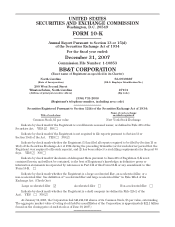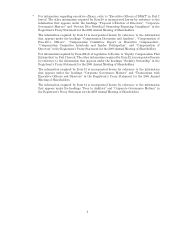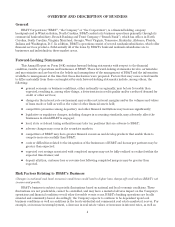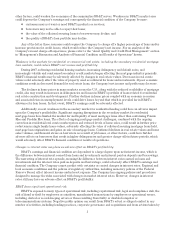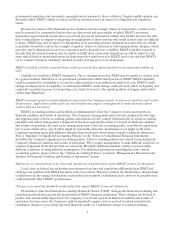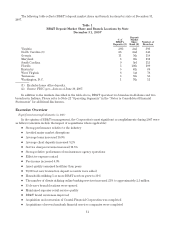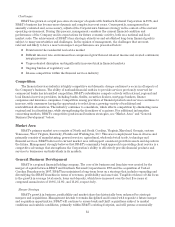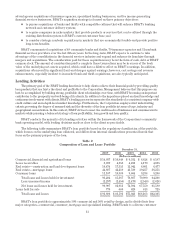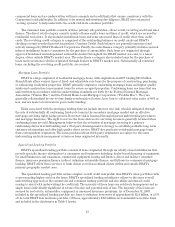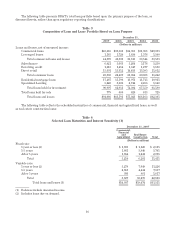BB&T 2007 Annual Report Download - page 6
Download and view the complete annual report
Please find page 6 of the 2007 BB&T annual report below. You can navigate through the pages in the report by either clicking on the pages listed below, or by using the keyword search tool below to find specific information within the annual report.government regulators and community organizations in response to those activities. Negative public opinion can
adversely affect BB&T’s ability to attract and keep customers and can expose it to litigation and regulatory
action.
Because the nature of the financial services business involves a high volume of transactions, certain errors
may be repeated or compounded before they are discovered and successfully rectified. BB&T’s necessary
dependence upon automated systems to record and process its transaction volume may further increase the risk
that technical flaws or employee tampering or manipulation of those systems will result in losses that are difficult
to detect. BB&T may also be subject to disruptions of its operating systems arising from events that are wholly
or partially beyond its control (for example, computer viruses or electrical or telecommunications outages), which
may give rise to disruption of service to customers and to financial loss or liability. BB&T is further exposed to
the risk that its external vendors may be unable to fulfill their contractual obligations (or will be subject to the
same risk of fraud or operational errors by their respective employees as is BB&T) and to the risk that BB&T’s
(or its vendors’) business continuity and data security systems prove to be inadequate.
BB&T’s liquidity could be impaired by an inability to access the capital markets or an unforeseen outflow of
cash.
Liquidity is essential to BB&T’s businesses. Due to circumstances that BB&T may be unable to control, such
as a general market disruption or an operational problem that affects third parties or BB&T, BB&T’s liquidity
could be impaired by an inability to access the capital markets or an unforeseen outflow of cash. BB&T’s credit
ratings are important to its liquidity. A reduction in BB&T’s credit ratings could adversely affect its liquidity and
competitive position, increase its borrowing costs, limit its access to the capital markets or trigger unfavorable
contractual obligations.
BB&T’s accounting policies and methods are key to how the Company reports its financial condition and results
of operations. Application of these policies and methods may require management to make estimates about
matters that are uncertain.
BB&T’s accounting policies and methods are fundamental to how the Company records and reports its
financial condition and results of operations. The Company’s management must exercise judgment in selecting
and applying many of these accounting policies and methods so they comply with generally accepted accounting
principles and reflect management’s judgment of the most appropriate manner to report its financial condition
and results of operations. In some cases, management must select the accounting policy or method to apply from
two or more alternatives, any of which might be reasonable under the circumstances yet might result in the
Company reporting materially different amounts than would have been reported under a different alternative.
Note 1 “Summary of Significant Accounting Policies” in the “Notes to Consolidated Financial Statements”
describes the Company’s significant accounting policies. These accounting policies are critical to presenting the
Company’s financial condition and results of operations. They require management to make difficult, subjective or
complex judgments about matters that are uncertain. Materially different amounts could be reported under
different conditions or using different assumptions. For additional information regarding the more critical
accounting policies, please refer to the “Critical Accounting Policies” section in “Management’s Discussion and
Analysis of Financial Condition and Results of Operations” herein.
Differences in interpretation of tax laws and regulations may adversely impact BB&T’s financial statements.
Local, state or federal tax authorities may interpret tax laws and regulations differently than BB&T and
challenge tax positions that BB&T has taken on its tax returns. This may result in the disallowance of deductions
or differences in the timing of deductions and result in the payment of additional taxes, interest or penalties that
could materially affect BB&T’s performance.
Changes in accounting standards could materially impact BB&T’s financial statements.
From time to time the Financial Accounting Standards Board “FASB” changes the financial accounting and
reporting standards that govern the preparation of BB&T’s financial statements. These changes can be hard to
predict and can materially impact how the Company records and reports its financial condition and results of
operations. In some cases, the Company could be required to apply a new or revised standard retroactively,
resulting in changes to previously reported financial results, or a cumulative charge to retained earnings.
6

